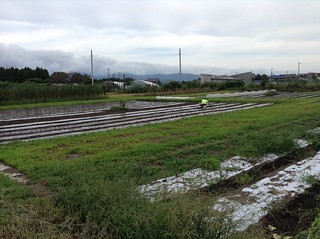All is not well on the Japanese farm.
The average age of a Japanese farmer in 2007 was 63.2 years old. Today it has climbed to 66.4. Of those, 63.5% are 65 years of age or older.
In 2007, there were 3,3530,000 farmers spread around Japan. Today just 2,097,000 farmers remain, many on postage stamp plots growing heavily subsidized rice soaked in chemical fertilizer and pesticide.
The above data comes from the 2015 government agriculture census. Moreover, according to the 2010 census, fewer than one million Japanese farmers earn their living exclusively from farming. Most, in other words, are farming as a side business. 70% earn less than two million yen ($20,000) per year from agriculture.
 And, last statistic (promise!), this is in a country that is supplying just 39% of its populations caloric needs. (This statistic is fungible - and depends on the way the data is counted. In Japan, it is counted on a calorie base. Other countries use different metrics. Still, Japan is a laggard in this respect - see source #4 below.)
And, last statistic (promise!), this is in a country that is supplying just 39% of its populations caloric needs. (This statistic is fungible - and depends on the way the data is counted. In Japan, it is counted on a calorie base. Other countries use different metrics. Still, Japan is a laggard in this respect - see source #4 below.)The election of Donald Trump may actually, for the time being, serve as a life line to Japanese agriculture. The 12-nation Trans-Pacific Partnership (TPP) free trade bloc - which Trump campaigned against - would no doubt have flooded Japan with cheap farm products from mega-producers in the United States and other countries where large scale factory farming takes place. That would have pushed more pensioner farmers into retirement, speeding the decline in number of active farmers.
What is the solution according to Prime Minister Shinzo Abe? Well, until the election of Trump, it was TPP, creating huge farms that could compete internationally.
The problem with this, aside from environmental issues - yes, it would be worse than the current situation even with Japan's heavy dependence on chemical fertilizers - is that Japan's topography does not allow the kind of farming that occurs in the USA, Australia, Germany, and France. 70% of the country is mountainous and makes large-scale farming all but impossible.
A more personal solution: buy or rent land in the countryside and grow your own food. Land is cheap because Japanese cannot conceive of life without a convenience store nearby; as a result, a short drive outside of any metropolitan area in Japan takes you to a fast depopulating area filled with fields gone to seed and many elderly people.
The farm pictured above is an organic farm in Shiga Prefecture, about 30 minutes from Kyoto. It is roughly 4500 square meters (about 140 meters x 140 meters) and run by two farmers in their late 30s. They are the exception to nearly every trend in Japanese agriculture.
Sources:
1)??????Summer 2016
2)http://ameblo.jp/orange54321/entry-11873717276.html
3)http://www.maff.go.jp/j/zyukyu/zikyu_ritu/013.html
4)http://www.osaka-c.ed.jp/ed/h14/kankyou/security/Food/jikyuu2.htm
� JapanVisitor.com
Goods From Japan delivered to your home or business
Tidak ada komentar:
Posting Komentar